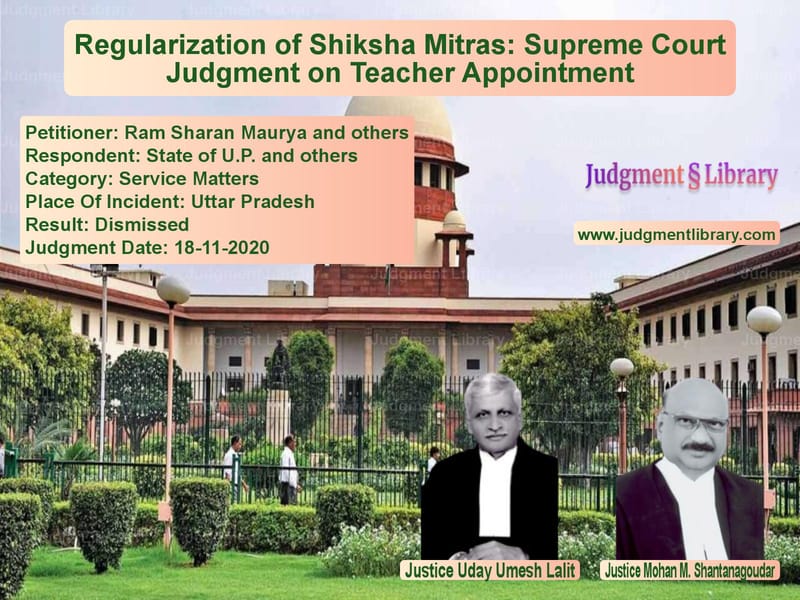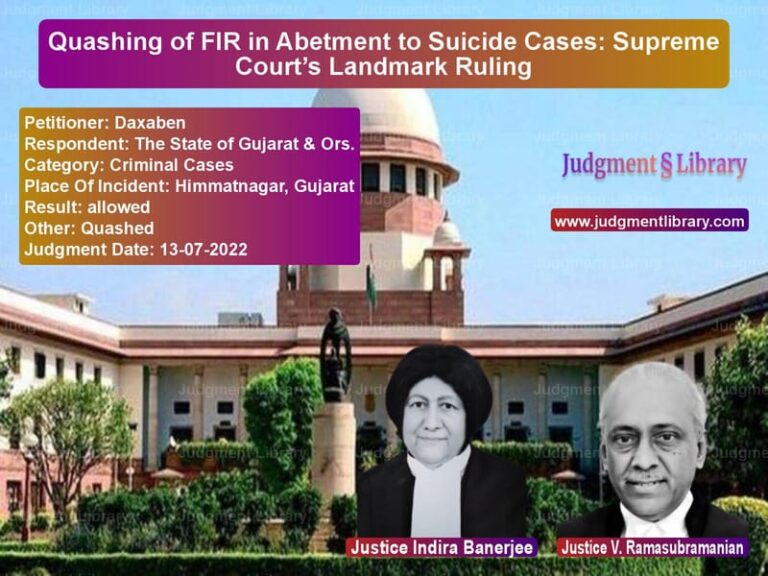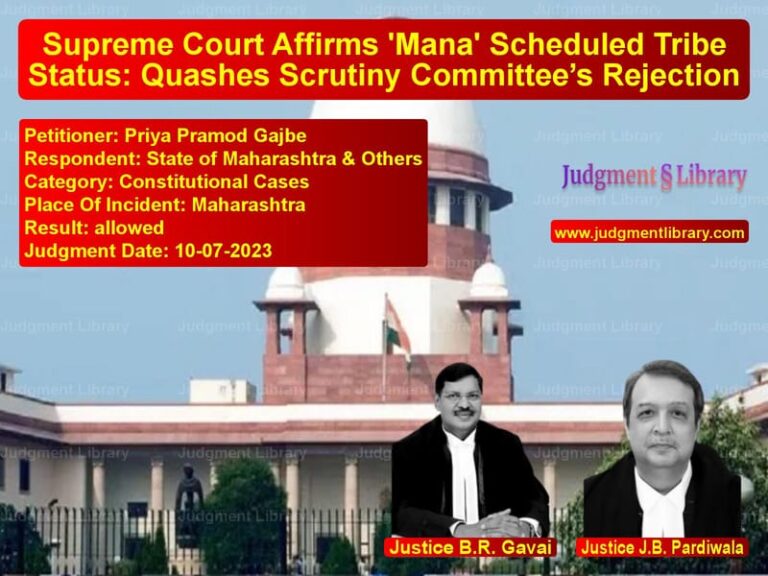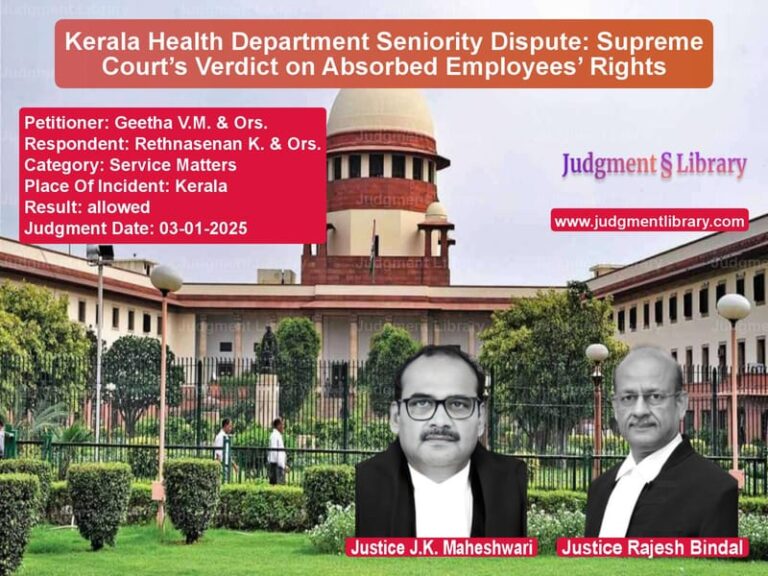Regularization of Shiksha Mitras: Supreme Court Judgment on Teacher Appointment
The case at hand involves a crucial issue of teacher regularization in Uttar Pradesh, specifically concerning the position of Shiksha Mitras. The petitioners, Ram Sharan Maurya and others, have filed a petition against the State of Uttar Pradesh and other parties, seeking a ruling on the legality of the regularization of Shiksha Mitras in junior basic schools. The dispute arose when the Uttar Pradesh Government sought to regularize Shiksha Mitras as Assistant Teachers in government schools, despite the contention that they did not meet the eligibility requirements stipulated by law for such appointments. This case examines the interpretation of education policy, the legal qualifications required for teaching positions, and the right of the petitioners to be regularized under the existing framework.
Background of the Case
The petitioners in the case were Shiksha Mitras who had been working in various schools in Uttar Pradesh for several years. They had been appointed as contract teachers but had not been provided with formal appointments or benefits associated with government employment. The Uttar Pradesh Government, in 2015, issued a notification offering to regularize these Shiksha Mitras as Assistant Teachers based on their prior teaching experience and completion of an educational qualification in accordance with the Teacher Eligibility Test (TET). The petitioners argue that despite meeting some of the criteria, the regularization process violated their constitutional right to equal treatment under Article 14 of the Constitution of India. They further contend that the process of regularization contravenes the standards laid down by the National Council for Teacher Education (NCTE) and violates other legal and procedural guidelines.
Petitioner’s Arguments
The petitioners, represented by learned counsel, presented the following key arguments:
- The regularization process was arbitrary and lacked transparency. The petitioners argued that there were no clear criteria for regularization, and the appointments were made without a fair and structured examination of eligibility based on educational qualifications.
- The petitioners also argued that the process violated the guidelines of the NCTE, which mandates that all teachers must meet specific eligibility criteria, including passing the Teacher Eligibility Test (TET) and having an appropriate educational background.
- The petitioners further contended that the denial of equal treatment to those who were not eligible for regularization was unconstitutional and violated their fundamental rights under Article 14 of the Indian Constitution, which guarantees equality before the law.
“The lack of transparency and the arbitrary nature of the regularization process is a clear violation of the constitutional principles that ensure equality and fairness in government employment.”
Respondent’s Arguments
The respondents, representing the State of Uttar Pradesh, countered the petitioners’ claims with the following arguments:
- The State defended the regularization process, asserting that the policy was in accordance with the State Government’s educational needs and the applicable law.
- The State emphasized that the Shiksha Mitras had been performing teaching duties for several years and had contributed significantly to the education sector, which justified their regularization. The government argued that the regularization process would provide job security and formal employment benefits to these teachers.
- The State argued that the petitioners had not fulfilled all the eligibility requirements, including passing the TET, which was an essential qualification. The State also emphasized that the Government’s actions were within the purview of its power to regulate the education system and make decisions that benefit the larger public interest.
“The regularization of Shiksha Mitras is a policy decision taken in light of the educational needs of the State. It was done in a transparent manner and with due consideration to the public interest, providing much-needed stability to these teachers.”
Supreme Court’s Judgment
The Supreme Court, after hearing the arguments from both parties, delivered its judgment. The Court’s key observations included:
- The Court recognized the importance of regularizing teachers who had been working for several years in the education sector and who had met certain educational qualifications. However, it also emphasized that the regularization process must adhere to the legal guidelines and standards laid down by the NCTE.
- The Court noted that the regularization of Shiksha Mitras could not be done arbitrarily and must be done in a manner that ensures fairness and transparency. The Court directed that the regularization process should include an examination of each teacher’s eligibility, including whether they had passed the TET and met the educational qualifications required under the law.
- In addition, the Court observed that the State Government had not followed a fair procedure in implementing the regularization policy, particularly in relation to the selection process and the criteria for regularization.
- However, the Court also highlighted the significant contribution made by Shiksha Mitras to the education system and directed the State Government to take necessary steps to address the issue of job security for these teachers in a manner that adheres to the legal and constitutional principles of equality and fairness.
“While we acknowledge the valuable contribution of Shiksha Mitras to the education system, the process of regularization must follow legal standards to ensure fairness and transparency. The State must take appropriate steps to address these concerns while providing job security.”
Conclusion
The judgment reinforces the importance of adhering to legal and procedural standards in matters of regularization and public employment. It upholds the principle that any regularization process must be transparent, fair, and in compliance with established legal frameworks. The ruling provides a balance between addressing the educational needs of the State and ensuring that teachers meet the necessary qualifications to be appointed as permanent employees. It serves as a reminder to governments that decisions affecting employment and public welfare must be made with due consideration to the law and the principles of equality and fairness.
Petitioner Name: Ram Sharan Maurya and others.Respondent Name: State of U.P. and others.Judgment By: Justice Uday Umesh Lalit, Justice Mohan M. Shantanagoudar.Place Of Incident: Uttar Pradesh.Judgment Date: 18-11-2020.
Don’t miss out on the full details! Download the complete judgment in PDF format below and gain valuable insights instantly!
Download Judgment: Ram Sharan Maurya an vs State of U.P. and ot Supreme Court of India Judgment Dated 18-11-2020.pdf
Direct Downlaod Judgment: Direct downlaod this Judgment
See all petitions in Employment Disputes
See all petitions in Recruitment Policies
See all petitions in Public Sector Employees
See all petitions in Termination Cases
See all petitions in Workplace Harassment
See all petitions in Judgment by Uday Umesh Lalit
See all petitions in Judgment by Mohan M. Shantanagoudar
See all petitions in dismissed
See all petitions in supreme court of India judgments November 2020
See all petitions in 2020 judgments
See all posts in Service Matters Category
See all allowed petitions in Service Matters Category
See all Dismissed petitions in Service Matters Category
See all partially allowed petitions in Service Matters Category







